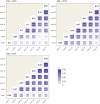Age-dependent genetic architecture across ontogeny of body size in sticklebacks
- PMID: 35582807
- PMCID: PMC9118060
- DOI: 10.1098/rspb.2022.0352
Age-dependent genetic architecture across ontogeny of body size in sticklebacks
Abstract
Heritable variation in traits under natural selection is a prerequisite for evolutionary response. While it is recognized that trait heritability may vary spatially and temporally depending on which environmental conditions traits are expressed under, less is known about the possibility that genetic variance contributing to the expected selection response in a given trait may vary at different stages of ontogeny. Specifically, whether different loci underlie the expression of a trait throughout development and thus providing an additional source of variation for selection to act on in the wild, is unclear. Here we show that body size, an important life-history trait, is heritable throughout ontogeny in the nine-spined stickleback (Pungitius pungitius). Nevertheless, both analyses of quantitative trait loci and genetic correlations across ages show that different chromosomes/loci contribute to this heritability in different ontogenic time-points. This suggests that body size can respond to selection at different stages of ontogeny but that this response is determined by different loci at different points of development. Hence, our study provides important results regarding our understanding of the genetics of ontogeny and opens an interesting avenue of research for studying age-specific genetic architecture as a source of non-parallel evolution.
Keywords: Pungitius; QTL mapping; genetic architecture; genetic correlation; heritability; ontogeny.
Conflict of interest statement
We declare we have no competing interests.
Figures


Similar articles
-
Quantitative trait loci for growth and body size in the nine-spined stickleback Pungitius pungitius L.Mol Ecol. 2013 Dec;22(23):5861-76. doi: 10.1111/mec.12526. Epub 2013 Nov 5. Mol Ecol. 2013. PMID: 24102814
-
Heterogeneous genomic architecture of skeletal armour traits in sticklebacks.J Evol Biol. 2024 Aug 27;37(9):995-1008. doi: 10.1093/jeb/voae083. J Evol Biol. 2024. PMID: 39073424
-
Deciphering the genomic architecture of the stickleback brain with a novel multilocus gene-mapping approach.Mol Ecol. 2017 Mar;26(6):1557-1575. doi: 10.1111/mec.14005. Epub 2017 Jan 27. Mol Ecol. 2017. PMID: 28052431
-
The genetic and molecular architecture of phenotypic diversity in sticklebacks.Philos Trans R Soc Lond B Biol Sci. 2017 Feb 5;372(1713):20150486. doi: 10.1098/rstb.2015.0486. Philos Trans R Soc Lond B Biol Sci. 2017. PMID: 27994127 Free PMC article. Review.
-
Nine-spined stickleback (Pungitius pungitius): an emerging model for evolutionary biology research.Ann N Y Acad Sci. 2013 Jun;1289:18-35. doi: 10.1111/nyas.12089. Epub 2013 Mar 29. Ann N Y Acad Sci. 2013. PMID: 23550583 Review.
Cited by
-
Age-Dependent Growth-Related QTL Variations in Pacific Abalone, Haliotis discus hannai.Int J Mol Sci. 2023 Aug 29;24(17):13388. doi: 10.3390/ijms241713388. Int J Mol Sci. 2023. PMID: 37686194 Free PMC article.
-
Complex and Dynamic Gene-by-Age and Gene-by-Environment Interactions Underlie Functional Morphological Variation in Adaptive Divergence in Arctic Charr (Salvelinus alpinus).Evol Dev. 2025 Mar;27(1):e70000. doi: 10.1111/ede.70000. Evol Dev. 2025. PMID: 39723482 Free PMC article.
References
Publication types
MeSH terms
LinkOut - more resources
Full Text Sources

